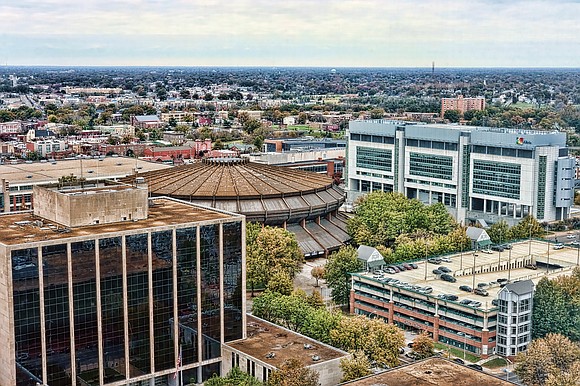Navy Hill ship sinking?
Scrutiny of Coliseum replacement plan reveals major gaps
Jeremy M. Lazarus | 10/31/2019, 5:56 p.m.
The grand plan Mayor Levar M. Stoney is pushing to replace the Richmond Coliseum with $1.5 billion in new Downtown development does not appear to include enough affordable housing to meet a City Council requirement.
The plan also would require a major shift of $316 million in taxpayer dollars to pay off the borrowing for a key element of the plan — a proposed 17,500-seat replacement for the vacant and closed Coliseum.
Meanwhile, the financial projections underpinning the city’s plan to borrow the money to pay for the new arena appear to have become shakier, while projections of the jobs that would be created appear to be inflated and also apply to the entire Richmond region, not just to the city.
These are among a series of bombshell concerns that have hit the Navy Hill Development Corp. proposal that Mayor Stoney touts as a key way to rejuvenate a government-dominated section of Downtown while increasing housing choices and employment opportunities for city residents.
When it comes to affordable housing, the plan that Mayor Stoney submitted to the council does not meet the new policy that City Council approved earlier this year regarding residential developments.
That policy requires a developer to include a minimum of 15 percent of affordable housing in any project that involves the use of city property — as the Navy Hill project would.
The proposal that Mayor Stoney submitted on behalf of the Navy Hill District Corp. calls for nearly 2,300 new apartments, offices and other elements to be developed primarily on city-owned land located between City Hall and the Coliseum and on two blocks south of Broad Street.
Of those units, only 280 are proposed to be affordable, according to Navy Hill officials, meaning they would be targeted to people making 80 percent or less of the Metro Richmond median household income of $83,200. The median is the income point at which half of households are above and half are below. According to government figures, 80 percent of the median would range from $46,600 a year or less for an individual, to $66,550 or less for a family of four.
At a briefing on Oct. 14, City Council members expressed dissatisfaction with the Navy Hill District Corp.’s plan to work with the nonprofit Better Housing Coalition to develop at least 200 additional affordable housing units in other sections of Downtown, including Jackson Ward.
Based on the discussion, most of the council members indicated they would reject that approach and would want additional affordable units to be included in the Navy Hill-developed apartments. To meet the new policy, Navy Hill would need to boost its total of affordable units to nearly 350 to meet the policy.
That issue surfaced just a few days before another bombshell dropped at the Oct. 19 meeting of City Council’s Navy Hill Development Advisory Commission.
Commission Vice Chairman John Gerner, using published figures from Navy Hill and its financial advisers, told members that $316 million in real estate taxes would be shifted over 30 years to a special fund to be used to repay the estimated $311 million to be borrowed to build a new Coliseum.
Including interest, the cost of repaying the debt on the new Coliseum could run between $480 million and $600 million, depending on how quickly or slowly the payments are made.
Mr. Gerner told the commission he employed the same framework that he would use in assessing projects by government and private clients of his consulting business. He is the first to quantify the size of the investment the city would need to make to support the project. That does not include the cost of additional police, firefighters and other employees that would be required if the development takes place.
Under the plan introduced by Mayor Stoney, the city would continue to receive the same amount of real estate tax from an 80-block area of Downtown that currently goes into the city’s general fund, but any new income from real estate taxes generated by growth in valuations of the property would be shifted to a fund to pay off the Coliseum debt.
Mr. Gerner’s analysis also confirmed that the city government would not see any financial return during the first five years of the project and might have to wait up to 20 years to see any real return, assuming the development lives up to projections.
Meanwhile, at the Oct. 14 briefing, the city’s financial adviser, Davenport & Co., told the council members that the financial projections for repaying the debt on the new Coliseum could be upended if Dominion Energy does not build a second office tower near the Downtown riverfront.
The company has completed one tower on Canal Street and vacated its former Virginia headquarters next door, One James River Plaza, which is to be razed. However, Dominion Energy has not committed to building the second tower.
The energy company, led by Thomas F. Farrell II, has said that any decision would not be influenced by the Navy Hill project that Mr. Farrell also is spearheading.
According to Councilman Parker C. Agelasto, 5th District, council members were told that in order to sell the bonds to build a new arena, investors would need assurances and financial projections showing the city would maintain 1.5 times the annual repayment amount in the special fund and that may not be possible if the second tower is not built.
The minutes of the council meeting show that representatives of Navy Hill and its development arm sought to downplay the problem, noting that interest rates, and thus the cost of repayment, could go down as a result of the Federal Reserve cutting the interest rate. They also cited the likelihood that other developments could be built in the 80-block area that could reduce the reliance on Dominion’s second tower.
Still, Mr. Agelasto said he found it unsettling that the Navy Hill development is dependent on whether Dominion adds a second building.
And there are questions about the project proponents’ continuing assurances that the city government and Richmond taxpayers would face no future risk.
Justin Griffin, a small business attorney who has emerged as a key opposition leader to the Navy Hill development, reported that at 4th District Councilwoman Kristen N. Larson’s monthly meeting, representatives of Navy Hill backed away from the no risk claim, saying that no one had ever promised that the project would be risk-free.
Mr. Griffin also published on Facebook a new analysis of Virginia Commonwealth University’s projection that the Navy Hill development would generate 12,500 construction jobs and 9,000 permanent jobs.
He noted that the VCU figures are projected estimates of the number of jobs that the giant development would create across the Richmond region, and not just within the city.








